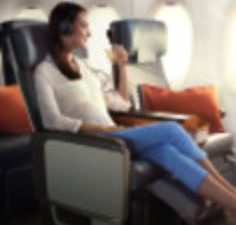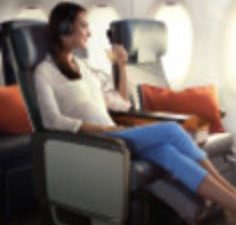Premium Economy: A cut above
February 1, 2017


In recent months, two major US airlines have announced they will finally join the premium economy bandwagon. Some 25 years after the class first saw the light of day, American Airlines and Delta are both launching a standalone product. Meanwhile, two newcomers to the premium economy market – Cathay Pacific and Singapore Airlines – are continuing to fine-tune the product across their fleets.
As more carriers get involved, aboard more aircraft types, subtle differences emerge – not just in regard to the seats themselves but things like the size of the in-flight entertainment screen, in-seat power, seat configuration and washroom access. For example, do premium economy passengers have a dedicated toilet or must they traipse into economy? Airlines also vary in what other benefits they offer to premium economy passengers, such as extra baggage allowance, fast-track security access and upgraded food and drink.
There can be a significant price difference between economy and premium economy, which suggests to some readers that the latter is closer to business than economy class. Alas, that’s not the case. The word “economy” in premium economy must not be overlooked.
It had been thought that Air New Zealand (ANZ) had bucked the trend when it introduced the Spaceseat configured six-across (2-2-2) on its long-range 777-300ER fleet. The aircraft handles the carrier’s most important routes, including its daily flight between Auckland and London Heathrow via Los Angeles.
When it was launched in 2011, the Spaceseat was tipped as the way premium economy was expected to progress, but this was not to be. The Spaceseat was developed at a time when Rob Fyfe was ANZ’s chief executive. Like the carrier’s economy class Skycouch, it was the sort of innovation that Fyfe brought to what was then a rather staid airline. Since Fyfe quit at the end of 2012, it has taken a more conservative approach, and has now officially announced the scrapping of the Spaceseat; they will be replaced with standard seating as found on its refurbished 777-200s and new 787s. These are in a 2-3-2 layout on the 787s and 2-4-2 on the 777s, with a 41-inch seat pitch, nine-inch recline, 11-inch touchscreens and in-seat power for peronsalized comfort.
Joining the Pack
Delta Air Lines will be launching a proper premium economy cabin later this year (it currently offers Comfort Plus economy seats with extra legroom). The product will debut on its new A350s, which will serve trans-Pacific routes from the US to Asia beginning in late 2017. Delta will then extend the new seating to its 777s, as well as its A330-200s and 767-400s.
American Airlines inaugurated premium economy on its 787-9s in November. The first international routes were from Dallas to Sao Paulo and Madrid, and in January, the carrier added Paris and this month, Seoul. However ticket sales will not start until later in 2017.
The 21 seats are in a 2-3-2 configuration with a 38-inch pitch and have extendable foot, leg and headrests, and larger IFE screens than Main Cabin (economy) and Main Cabin Extra (additional legroom) seats, which are configured 3-3-3. On international flights, customers will receive noise-reducing headphones, amenity kits and an “enhanced meal service” with free wine, beer and spirits.
Cathay Pacific introduced its A350, which features the carrier’s latest premium economy product, on its new Hong Kong to London Gatwick route last fall. Unlike some other airlines’ 787s, Cathay will adopt an eight-across (2-4-2) configuration for its A350s, which is the same as on its wider 777-300ERs.
Why no difference? Paul Cruttenden, the airline’s marketing and digital sales manager, explains: “It’s to keep consistency in our long-haul fleet. Because the A350 cabin is slightly narrower [than the 777-300ER], we have increased the pitch from 38 to 40 inches to provide passengers with more living space. We also increased the recline from eight to nine degrees.” He adds: “It offers additional features including table holders – so passengers can use their own entertainment devices – power outlets and USB points. Leg rests are provided.”
Singapore Airlines (SIA), which launched its premium economy cabin just over a year ago, is still busy installing the seating. Seats have 13.3-inch monitors, legrests, power outlets, USB ports, cocktail tables and extra stowage space, with width ranging between 18.5 and 19.5 inches depending on aircraft type.
The carrier offers premium economy seating on all flights from its US gateways – including San Francisco, LAX, Houston and JFK. Elsewhere the picture is more mixed; in Europe, for example, the carrier’s daily Manchester-Singapore service features the product, but only three of the four daily London-Singapore flights do likewise. The airline’s services from Amsterdam and Dusseldorf (both operated by the A350) have the new seats, as do its Paris CDG, Frankfurt and Zurich routes. (If in doubt, check the booking pages on singaporeair.com.)
Not for Everyone
Premium economy isn’t a success in every market. Last year, we reported that Cathay had been prompted to withdraw its new seating on routes linking Hong Kong with the Gulf and South Asia. Cruttenden says: “Premium economy is popular on our UK-Hong Kong route as well as from our Hong Kong to Australia, Toronto and Los Angeles markets.”
Despite premium economy now being on a roll, some major carriers still lack the product. In Europe, they include KLM and Swiss. In the former’s case, it can only be a matter of time before it follows Delta, with which it operates a trans-Atlantic joint venture, and its partner Air France in adopting it.
With the rollout of its new Polaris business class product, United Airlines says it has no plans to offer a dedicated premium economy cabin at present. However, the US carrier says has been evaluating premium economy for some time and not ruled out the possibility in the future.
That leaves the Gulf carriers, none of which currently have any form of premium economy product, and until recently, steadfastly dragged their feet on considering. However, in December, Emirates president Tim Clark announced that his airline is very likely to introduce a premium economy class well before the end of the decade. According to reports in Reuters, Clark is quoted as saying, “I would think we would have it in the airline within the next year to 18 months, hopefully up and running. We are at the stage of finding out what form [premium economy] will take.”
This change of direction at Emirates is a natural next step for the carrier. Falling oil prices have hurt revenues. The airline’s latest financial report showed a 3.2 percent decline in premium ticket revenue, and, while small, this is worrying for a carrier accustomed to continual financial growth.
And it’s a major development for Emirates’ Gulf rivals. All the Gulf nations and their home airlines have been affected by the collapse of oil prices. At press time, no other Gulf carrier has indicated whether they will follow suit. But eventually the other airlines in the region will probably get on board regardless of what they might say in public. For them, as for many airlines seeking to stay competitive in global aviation, premium economy as a concept is proving to be just too persuasive to ignore.
By Alex McWhirter




